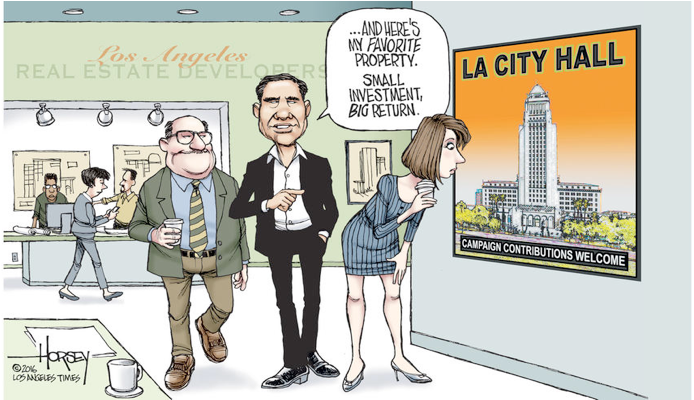Education Politics and Our Billionaire Future
THE EVE OF DESTRUCTION-As I write this, rescuers in central Italy are desperately trying to pull victims out from a hotel that was buried in tons of snow by an avalanche.
The avalanche was caused by a series of earthquakes.
Although they can be extremely destructive, earthquakes are natural phenomena.
On January 18, we learned that public education in Los Angeles was buried by a million dollar avalanche in the form of a single contribution to a local school board race by former mayor and billionaire Richard Riordan.
Riordan is only one of many billionaires who have decided to use their vast resources in an attempt to drown out electoral competition. But there is no precedent for a million dollar campaign contribution in a municipal school board race.
In the world of Education Reform, the GOP and the billionaires have found common ground in their rampage against the spirit of public education. We all know their names: Walton. Gates. Bezos. Zuckerberg. Individuals whose money buys them tremendous political clout. Consider this from Besty DeVos, Donald Trump’s nominee to become Secretary of Education:
“My family is the largest single contributor of soft money to the national Republican Party…I have decided, however, to stop taking offense at the suggestion that we are buying influence. Now, I simply concede the point. We expect to foster a conservative governing philosophy consisting of limited government and respect for traditional American virtues. We expect a return on our investment; we expect a good and honest government. Furthermore, we expect the Republican Party to use the money to promote these policies and, yes, to win elections.”
Few confirmation nomination hearings were as depressing as multi-billionaire DeVos’ pathetic stumbling over understanding federal mandates or even basic education questions. This is a woman who never studied education or attended public school or sent her children to public school; she has never held an education position. DeVoss listed as her qualifications for the position in the form of Letters to the Editor and press releases. She claims that she would still be nominated even if she hadn’t contributed over $200 million to the GOP -- that she wasn’t buying the influence she claimed earlier that, well, she was intent on buying.
In a December, 2010 New Yorker profile on Eli Broad entitled, “The Art of the Billionaire: How Eli Broad took over Los Angeles,” former mayor Antonio Villaraigosa provided this swooning support: “What is Los Angeles -- when they write the chronicles of LA -- without Eli Broad? He can close his eyes and see the future.”
In the shadow of Hollywood, Villaraigosa parrots one of the great confrontation scenes in cinematic history. When Jack Nicholson’s 1940’s PI Jake Gittes goes up against multi-millionaire Noah Cross (John Huston somehow channeling contemporary Eli Broad) and demands to know why brute power is so important to him, he says: “Why are you doing it? What could you buy that you can’t already afford?”
Cross gleefully (and horrifically) responds, “The future, Mr. Gittes! The future!”
And yes, that future is the common denominator that these financial titans are determined to buy for their own and on their terms.
Broad’s tremendous (and outlandish) financial support has provided the backing for much of LA’s and the nation’s Ed Reform movement through his goofy, self-aggrandizing “Broad Academy” of superintendents. His greatest achievement was forcing the installation of academically and ethically challenged John Deasy to head LAUSD. After his tumultuous reign and disastrous stewardship of its finances and pedagogy, Broad took Deasy back into his secret lair, providing him ample compensation for training other “leaders” of his same mindset. Deasy rarely slinks back into public view, only choosing rare editorial appearances in the safe, rich confines of the Campbell Brown right-wing School Reform publication, The 74 (which also runs its sister LA School Report.) Follow the dominoes. It’s funding is through – sigh -- Betsy DeVos.
In blue, blue, blue California, you are obviously going to get nowhere if you adhere to a Right Wing social agenda. The neo-liberal Education Reform Democrats eschew that portion of the GOP horror show and pretend that they are not connected to Neanderthal thinking.
It is no surprise that the billionaires have been very quiet about DeVos’ nomination because they know they are wading into dangerous territory by supporting her. They actually support many of her privatization and charter initiatives, but of course her repugnant other right-wing beliefs are areas they are loathed to get mixed up in.
This has always been the conundrum for Ed Reform Democrats who share the same Education Reform mentality with some of the most grotesque reactionary figures of the Republican Party. The Democrats who are running for school boards (and here in California, they are all “proud” Democrats) and who garner billionaire dollars may think Trump, DeVos and other Republicans might be wrong about economics, gay rights, Civil Rights, Women’s Rights, environmental policies or taxes, but they believe the Right Wing are geniuses about Education Policy.
The sole issue that separates the Education Reform Democrats from their GOP counterparts is vouchers, which, ironically, Charters also have huge financial incentive to oppose.
This was the California Charter School Association’s take on Betsy DeVos after Trump nominated her for the Education Secretary position:
“We congratulate Betsy DeVos, a longtime supporter of charter schools, on her appointment as Secretary of Education. Mrs. DeVos has long demonstrated a commitment to providing families with improved public school options and we look forward to working with the administration on proposals allowing all students in California to access their right to a high quality public education. We encourage DeVos and the new administration to craft broad policies allowing all students and families to continue accessing the quality educational options they deserve.”
Monica Garcia, the school board representative of LA’s 2nd District, is a long time Ed Reform favorite of billionaires and CCSA. She is not a Progressive. Right Wing education champions endorse her and her pedagogy. A Betsy DeVos stewardship of education would find quite an ally in Garcia in many areas they both support. Her championing of John Deasy’s pedagogy, charters and privatization has been miserable for the children of LA and stand in stark contrast to the fundamental ideals that Progressive educators value.
Although School Board President Steve Zimmer’s voting record hardly seems to warrant Riordan’s financial assault on him -- since he actually has supported many of the things Riordan demands -- the name of Riordan’s organization, “LA Students for Change, Opposing Steve Zimmer for School Board 2017,” is just too stupid to be real. But, alas, it is.
If only there was some Progressive Billionaire who would front an organization called, “Students Opposed to Dick Riordan’s Green Hose Spraying Millions of Students.” That would be an attention getter and as legitimate and accurate a moniker.
With the advent of Trump’s absurdly plutocratic administration -- whose members’ portfolios and bank accounts boast their vile ability to influence public policy -- Richard Riordan’s fat, gold and diamond-encrusted finger on the scale has coarsened our Democracy. The whole idea and philosophy of Public Education will be lost under the weight of this dirty cash that opposes and oppresses it.
I’m afraid that there is very little Progressives can do on horseback when confronted with the tanks and artillery Riordan and his billionaire kin can muster. Guerilla fighting in the hills might be our only recourse as we hope for a more enlightened time to re-emerge.
The billionaire and Republican Party policies are going to define public education from now on. I have no idea how long it will take for us to dig out from the blizzard of grim policies that will smother us. The Supreme Court’s valentine to the rich through their Citizens United decision has also brought us a climate change of crisis in the role of politics and finances.
Richard Riordan and the other plutocrats are single-handedly buying the “future” they insist we all must endure.
Grab your shovels now, Progressives.
(Joshua Leibner taught in LAUSD public schools for 20 years. He is a National Board Certified teacher.) Edited for CityWatch by Linda Abrams.








 We have the power to stop this administration from targeting communities of color and deporting millions of people who have known no other home than the United States.
We have the power to stop this administration from targeting communities of color and deporting millions of people who have known no other home than the United States. Yesterday was the beginning of a movement where millions of women (and men) rose up to challenge lawmakers in Washington who are trying to take us backward. This movement knows that the arc of the universe is slow, but it bends toward justice -- and it is now our responsibility to continue our work and bend it ourselves.
Yesterday was the beginning of a movement where millions of women (and men) rose up to challenge lawmakers in Washington who are trying to take us backward. This movement knows that the arc of the universe is slow, but it bends toward justice -- and it is now our responsibility to continue our work and bend it ourselves.







 Helen Reddy’s a capella rendition of her feminist anthem, “I Am Woman,” spoke to those of us who are old enough to remember the seventies. Women, like one in a clip broadcast on the side of a media trailer, never believed they’d be marching again for battles fought decades ago. As I stood near the staging later in the day, I overheard a college student explain to a new friend that she had stumbled into the march– but “I’m also a feminist, you know.” If we’ve become complacent about defending our rights, this election and what’s at stake may serve as a wake-up call for those of us who have been politically active, as well as those who are new to the experience.
Helen Reddy’s a capella rendition of her feminist anthem, “I Am Woman,” spoke to those of us who are old enough to remember the seventies. Women, like one in a clip broadcast on the side of a media trailer, never believed they’d be marching again for battles fought decades ago. As I stood near the staging later in the day, I overheard a college student explain to a new friend that she had stumbled into the march– but “I’m also a feminist, you know.” If we’ve become complacent about defending our rights, this election and what’s at stake may serve as a wake-up call for those of us who have been politically active, as well as those who are new to the experience.  The mission of the Official Women’s March Los Angeles was to “stand together in solidarity for the protection of our rights, our safety, our health, and our families – recognizing that our vibrant and diverse communities are the strength of our country” and in support of “the advocacy and resistance movements that reflect our multiple and intersecting identities.” In many ways, the crowds that gathered downtown represent the diversity that makes our city so special, unified to defend the rights of all.
The mission of the Official Women’s March Los Angeles was to “stand together in solidarity for the protection of our rights, our safety, our health, and our families – recognizing that our vibrant and diverse communities are the strength of our country” and in support of “the advocacy and resistance movements that reflect our multiple and intersecting identities.” In many ways, the crowds that gathered downtown represent the diversity that makes our city so special, unified to defend the rights of all. 

 “If you’re disappointed by your elected officials, grab a clipboard, get some signatures, and run for office yourself.”
“If you’re disappointed by your elected officials, grab a clipboard, get some signatures, and run for office yourself.” 

 The neighborhood council (Mid City West Community Council) voted 22-6 to support the original 240 foot height of 333 La Cienega, and was touted by themselves and other project supporters as one of the crucial stakeholders able to influence the project. But it, too, was showing signs of disunion, through divergent takes on the value of the 333 project. “The reduction is a disappointment”, said Planning and Land Use chair Ravi Bhatia, who continued “the fund amount is only 1.4 units at MCW market price. City council does not understand the cost or importance of inclusionary zoning. Mom and pops must continue to bear the burden. It’s a land acquisition cost of well over $500,000 for mom and pops. They would still have to pay to build. That is one unit”.
The neighborhood council (Mid City West Community Council) voted 22-6 to support the original 240 foot height of 333 La Cienega, and was touted by themselves and other project supporters as one of the crucial stakeholders able to influence the project. But it, too, was showing signs of disunion, through divergent takes on the value of the 333 project. “The reduction is a disappointment”, said Planning and Land Use chair Ravi Bhatia, who continued “the fund amount is only 1.4 units at MCW market price. City council does not understand the cost or importance of inclusionary zoning. Mom and pops must continue to bear the burden. It’s a land acquisition cost of well over $500,000 for mom and pops. They would still have to pay to build. That is one unit”. 
 Arnold’s platform includes improved relations between police and citizens to reduce over-policing and use of excessive force. He cites the positive approach of bringing police together with citizens to address issues, promoting programs such as the Institute for Nonviolence in Los Angeles Days of Dialogue program on the Future of Policing, sponsored by Mark Ridley-Thomas’s office.
Arnold’s platform includes improved relations between police and citizens to reduce over-policing and use of excessive force. He cites the positive approach of bringing police together with citizens to address issues, promoting programs such as the Institute for Nonviolence in Los Angeles Days of Dialogue program on the Future of Policing, sponsored by Mark Ridley-Thomas’s office. 
 John Maynard Keynes, as well as Adam Smith and Friedrich Hayek, found the need to protect the Price System to be axiomatic – and what honest person wouldn’t? The Price System involves the billions of individual decisions made each day by billions of people about what to buy and what to sell and for how much. Adam Smith referred to this as the Invisible Hand which many people misunderstood to mean God. No, God does not set prices. People set the prices.
John Maynard Keynes, as well as Adam Smith and Friedrich Hayek, found the need to protect the Price System to be axiomatic – and what honest person wouldn’t? The Price System involves the billions of individual decisions made each day by billions of people about what to buy and what to sell and for how much. Adam Smith referred to this as the Invisible Hand which many people misunderstood to mean God. No, God does not set prices. People set the prices. 














